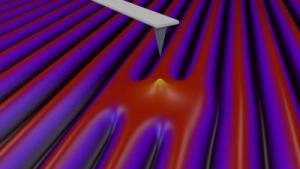Dec 17 2013
Atomic force microscopes are able to reproduce spectacular images, at the scale of single atoms. This is made possible by the oscillation of a very sharp probe tip over the surface being observed. The tip never touches the surface but gets so close to it, at distances in the order of one billionth of a metre, that it "feels" the force due to the interaction with the atoms making up the material being observed.
These are tiny forces, in the order of nanonewtons (meaning one billion times smaller than the weight of an apple). By measuring these forces one can reproduce an image of the material. A research group, which brings together experimental physicists from the University of Basel and theoretical physicists from SISSA, has observed and explained a peculiar effect, a source of "friction" in this type of nanoscopic observations.
 This is a graphical rendering of the "system" studied by Pellegrini, Santoro, and Tosatti. Credit: SISSA
This is a graphical rendering of the "system" studied by Pellegrini, Santoro, and Tosatti. Credit: SISSA
When the tip of the microscope oscillates over certain surfaces, in this case over NbSe2 (niobium selenide), peaks of "dissipation" (i.e., loss of energy) can be seen when the tip is at specific distances from the surface, as if it were held back, at certain locations, by some frictional force. This effect, which is related to a property of the surface known as charge density waves (CDW), was experimentally observed by the Basel physicists and first explained by Franco Pellegrini, Giuseppe Santoro and Erio Tosatti, of SISSA, by means of a theoretical model analysed with the use of numerical simulations.
"Our model describes in detail the interaction between the tip of the atomic force microscope and the CDW," explains Pellegrini. "The model reproduces – and predicts – the data observed experimentally".
"Knowledge of nanofriction is important today. Progressive miniaturization of electronic devices makes it crucial to understand the mechanisms underlying energy losses", continues Pellegrini. "In addition, thanks to our work we now have a more accurate description of charge density waves". The paper was published on December 15 in Nature Materials.